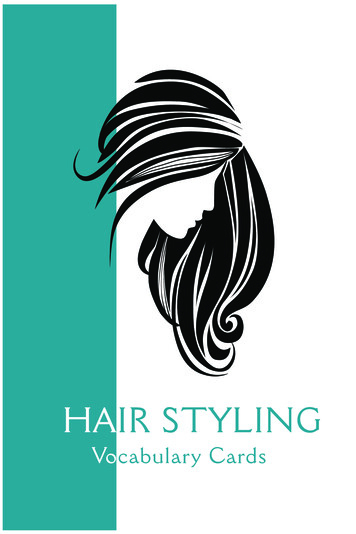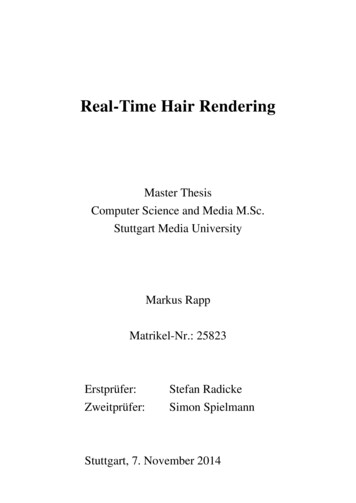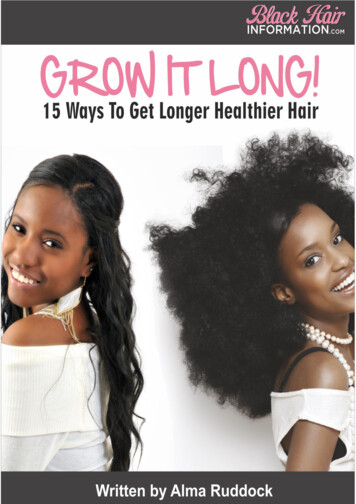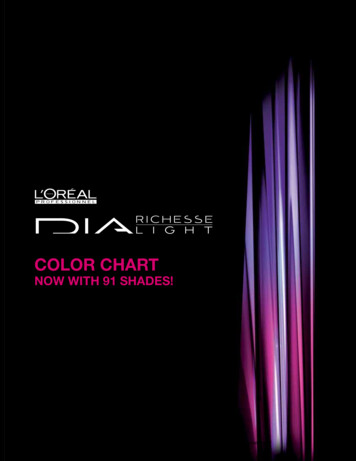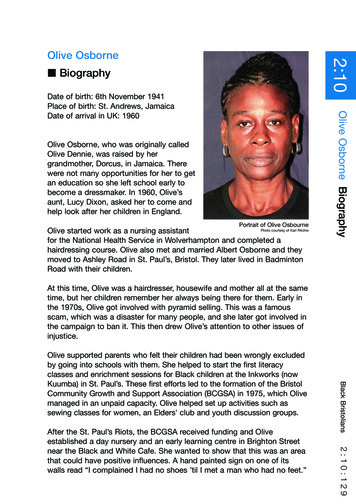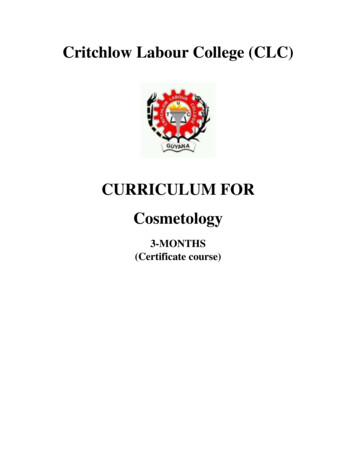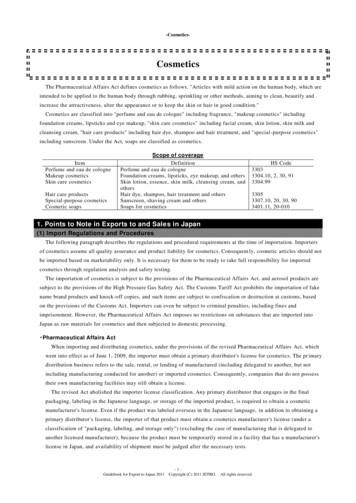
Transcription
THE HAIR STYLING ESSENTIALS HANDBOOKTHE HAIR STYLING ESSENTIALS HANDBOOKi
WELCOME TO THE WORLD OFHAIR STYLING!QC’s Hair Stying Essentials course is a great first step towards a career inbeauty and fashion. By learning even the simplest hair styling techniques, youare preparing yourself for success. Techniques like blow drying, back combing,braiding, and curling expand your skill set and make you an attractive prospectto potential employers. Understanding the fundamentals of hair styling alsoprepares you to work with clients professionally. You are on your way tomastering essential styling techniques and training as an expert in the fieldyou’re passionate about!THE HAIR STYLING ESSENTIALS HANDBOOK1
YOUR CAREER IN HAIR STYLINGYou know what hair stylists do, but do you want to learn more about theirdaily routine and responsibilities? This course is a great first step towards asuccessful styling career. Professional training builds a solid foundation foryou to develop your skills.THE HAIR STYLIST’S SKILL SETBecoming an expert requires a particular set of skills and personality traits.You’re part way there because you have a passion for hair design, but youmust be ready to practice each skill as well. Be creative: The more unique your hair styles are, the more in demandyour skills will be. Remember, however, that creative doesn’t necessarilymean crazy! Be Organized: Keep track of your schedule, meet your clients on time, andalways have the equipment you need cleaned and ready to go. Be prepared: Even when you’re well organized, things can go wrong. Beprepared to adapt and adjust to new circumstances. The best hair stylistsare problem solvers who can think outside the box. Be personable: Hair styling is a client-driven industry, so the happier youcan make your clients, the more positive referrals you’ll receive. Goodreviews mean more business for you. Communication and approachabilityare key tools in making your clients feel comfortable and well cared for. Be hungry: The most successful professional hair stylists never stoppracticing and learning, even once they’ve reached an expert level.THE HAIR STYLING ESSENTIALS HANDBOOK2
THE HAIR STYLIST AT A GLANCECheck out this list of characteristics! How many skills do you share withprofessional hair stylists? Don’t be too hard on yourself if you don’t feelconfident in very many of these areas. Remember, you’re still learning!A GOOD HAIR STYLIST: Is a creative person with an artistic eye Has a good sense of visual appeal and style Has confidence Has a good eye for detail Is energetic and has good stamina (you might work long days!) Is exceptional at listening and taking direction Can take on a leadership role Is a “people person” Is friendly, approachable and a good communicator Is flexible and adapts well to new situations Is punctual and reliable Is a problem solver Is willing to take risks Is professional and trustworthy Is passionate about the beauty industry Is willing to invest time in learning about new trends and techniquesTHE HAIR STYLING ESSENTIALS HANDBOOK3
WHERE DO HAIR STYLISTS WORK?Hair stylists can work in many different places depending on their skills andqualifications. As a hair stylist, you might work in a professional beauty salon,in a makeup studio or on-location at client’s homes or places of business.Many hair stylists will work freelance jobs for different types of eventsincluding weddings or special events, theater productions, fashion shows,or television or movie sets.THE HAIR STYLING ESSENTIALS HANDBOOK4
QUALITIES THAT WILL HELP YOU BE SUCCESSFULBecoming a professional hair stylist involves much more than simply making your clients look their best. In order to buildyour business, you must also build strong relationships with your clients. You must pay attention to their needs, addresstheir expectations, and practice good etiquette and hygiene.Remember that you’ll be standing very close to your client and touching her head, face, and hair. It will be very important toconduct yourself professionally and respectfully so that your client feels comfortable working with you.YOUR APPEARANCESENSITIVITIES AND ALLERGIESMAKING CONVERSATIONBEING RESPECTFULHow you present yourself to yourClients might be sensitive to certainProfessional stylists let their clientsSome professional hair stylists getclientsDressingredients in hair styling products.steer the conversation. Some peoplethe opportunity to work with publicprofessionally but comfortably, andAsk each person if they have anyare comfortable with small talk andfigures. Behaving respectfully ismake sure your clothes allow you toknown allergies before you start, andwill enjoy engaging with you. Othersalways important, but it is especiallymove easily.if there is any doubt, conduct a smallwill prefer to sit quietly while youcrucial if you are working with askin test. Apply a trace of the productwork. You should interact with yourcelebrity. Upsetting someone withon their inner arm, wait a few minutes,clients in whichever way seems toa lot of influence won’t be good forand then check for signs of redness.make them comfortable.your career.should smell pleasant but not overlyIf your client uses bad language,Make polite conversation, but avoidperfumed. Carry breath mints rathertellsorbringing up what you’ve read in thethan chewing gum.makeshowever,tabloids. Treating the client howdo not reciprocate. Maintain youryou would like to be treated is theprofessionalism at all times.best approach.speaksvolumes.Ensure that you always take care ofyour personal hygiene. Your clothingshould be wrinkle free and youTo your clients, your own appearanceis a reflection of your skills. Your hairinappropriateruderemarks,jokes,should be neat, clean, and well styledso that clients feel confident in yourability to make theirs the same.THE HAIR STYLING ESSENTIALS HANDBOOK5
TEN TIPS AND TRICKS FOR HAIR STYLING!Here is a glimpse into some of the techniques and tricks that are taught in QC’s Hair StylingEssentials Course. Tips like these help to form the base on which you’ll build more advanced skills.THE HAIR STYLING ESSENTIALS HANDBOOK6
1KEEP IT CLEANJust like other beauty experts, hair stylists must take special care to keep theirtools and work space clean and hygienic. Tools that are not properly cleanedcan become a home for bacteria, fungus, and parasites, which can be passedfrom client to client.If you style your clients’ hair without cleaning your tools or hands properlyand someone gets a scalp infection as a result, it can have a disastrouseffect on your reputation.2GETTING TO KNOW YOUProfessional hair stylists want to get to know their clients, but they also want toget to know their clients’ hair. Before styling, conduct a consultation meeting.When this meeting takes place and who will attend depends on the type ofjob you’re doing. For a wedding, you will meet with the bride several weeksbefore the big day. For a photo shoot, you will meet with models, designers,and photographers.One of the most important parts of the consultation meeting is learning aboutthe client’s hair. Ask her about how she normally styles her hair and whetherher hair has undergone any chemical treatments, including bleaching or dyejobs. These procedures affect the strength and overall health of the hair, andtherefore influence how you style it. You should also check whether the clienthas extensions.Finally, don’t forget to analyze the scalp. Brushing the hair will help youdetermine whether the scalp is healthy or whether you should avoid styling.THE HAIR STYLING ESSENTIALS HANDBOOK7
3TOOLS OF THE TRADEOne of the most important things you can learn during your hair stylingtraining is how each tool and product is used. Applying the right products tothe hair and using the correct tools properly are both essential to successfulhair styling.Getting to know the equipment in your styling kit will help you manipulate thehair to move and sit how you need it to for each look. Familiarizing yourselfwith products, tools, and their uses isn’t hard, but it does take practice.Using the wrong products can make styling more difficult than it might beotherwise. Using the wrong tools, or using your tools improperly, can affectyour styling process and even damage your client’s hair. Tool use takespractice, just like everything else!4BUILDING STYLES, BUILDING CONFIDENCEHair stylists do more than just make their clients look nice for a few hours.You’re helping each client you style feel confident and happy.This means that you should do your best to design a style that suits eachperson’s features, facial structure, and personality. The style should also beappropriate for the occasion. Being able to assess which styles suit your clientwill help you give her a look that makes her feel confident, stylish, and happy.THE HAIR STYLING ESSENTIALS HANDBOOK8
5TIPS FOR BLOW DRYINGBlow drying is a versatile skill. You can give your client’s hair body and volumeor make it appear sleek and smooth. You can create volume at the base forfurther styling or leave the hair blown smooth and voluminous for a simple,classic look. Here are some tips for effective blow drying: Always blow dry in layers. Always dry from root to tip. Avoid over-drying at all costs. Let hair dry 70% on its own before blow drying. Always use the right products for your client’s hair.6TIPS FOR CURLINGHair stylists use many different tools to curl hair. The technique for each tool issimilar, but creating successful curls with each type takes practice. Regardlessof which curling method you’re using, keep the following tips in mind: Make sure your ends are curled around the roller, iron barrel, or curlingtool with the rest of the strand. Pay attention to where you place the curl in relation to the base. When youwind the curling tool under from the tips of the hair toward the roots, it willnaturally pull in the direction that you’re rolling. Remember that the size of your curling tool will determine the size of your curls.THE HAIR STYLING ESSENTIALS HANDBOOK9
7TIPS FOR BACK COMBINGBack-combing is an effective method of creating volume at the roots,particularly near the crown of the head. You might also hear it referred to asback-brushing, teasing, or ratting. Pay attention to the following tips as youpractice back-combing: Never back-comb wet hair. When teasing the hair, always move your comb in a circular direction. Never rub the comb teeth or brush bristles up and down the hair strand,8or you will cause breakage and cuticle damage. Try teasing the crown for height before creating a wedding updo.BRAIDSMost braided styles build on the techniques that you’ll learn in the basic threestrand braiding pattern. Once you’ve mastered this fundamental style, you’llbe able to practice French braids, Dutch braids, rope braids, fish tail braids,and four-strands braids by altering the basic technique slightly and practicingdifferent ways of weaving the hair. Some hair stylists even invent their ownbraiding patterns. Once you’ve mastered a few different types of braids, trysome of the following styling tips: Try holding the middle strand of a three-strand braid and pushing theother strands so they slide upward. Creating a French braid that runs up the back of the head from the napeof the neck under a high bun can be a simple way to alter a classic style. Braids of all styles are versatile and can be incorporated into updos in anunlimited number of ways, so get as creative as you like.THE HAIR STYLING ESSENTIALS HANDBOOK10
9HAIR STYLING FOR MALE CLIENTSMany professional stylists work with male clients on a regular basis. Likewomen’s hair, men’s hair can be styled with flat irons, hot rollers, and curlingirons depending on its length.The styles you’ll create for men will vary from those you do for women, but thetechniques and how you use your tools and products will remain the same.While you style, you’ll consider face shape and facial structure just like youwould for a female client, but you’ll also pay attention to the hairline. Somemen experience a receding hairline and some might feel self-conscious aboutit. Take your client’s hairline into consideration like you would any other facialfeature. Remember that you want the client to feel confident when he seesthe final look.10PUTTING IT ALL TOGETHERMastering individual styling techniques is only half the battle when it comes tolearning hair styling. As you gain experience, you’ll find it easier to incorporateyour own creativity and ideas into the looks you create.By combining techniques and putting twists on classic styling elements likebraids and buns, you’ll be able to create your own custom updos. The bestway to find unique styles that you like and that your clients will enjoy is to playwith different styles and practice various combinations.The opportunity to be creative and innovative is what will keep your passionfor hair styling alive!THE HAIR STYLING ESSENTIALS HANDBOOK11
ABOUT QC MAKEUP ACADEMYIf you’re interested in starting a career in hair styling, QC’s Hair Styling Essentials coursemight be right for you! You’ll get a chance to learn and practice the basics of hair styling onyour own time with guidance from your personal tutor – a professional hair stylist.LEARN MORE ABOUT QC’SHAIR STYLING ESSENTIALS COURSEMEET THE TUTORSVIEW THE COURSE OUTLINETUITION FEES AND PAYMENT PLANS
JOIN THE QC COMMUNITY!CONTACT USWWW.QCMAKEUPACADEMY.COMEMAIL: INFO@QCMAKEUPACADEMY.COMUS & CANADA:1-800-267-1829UNITED KINGDOM:0800 066 4734AUSTRALIA:1 800 358 931NEW ZEALAND:0800 451 979STUDENT SHOWCASE
This means that you should do your best to design a style that suits each person’s features, facial structure, and personality. The style should also be appropriate for the occasion. Being able to assess which styles suit your client will help you give her a lo
